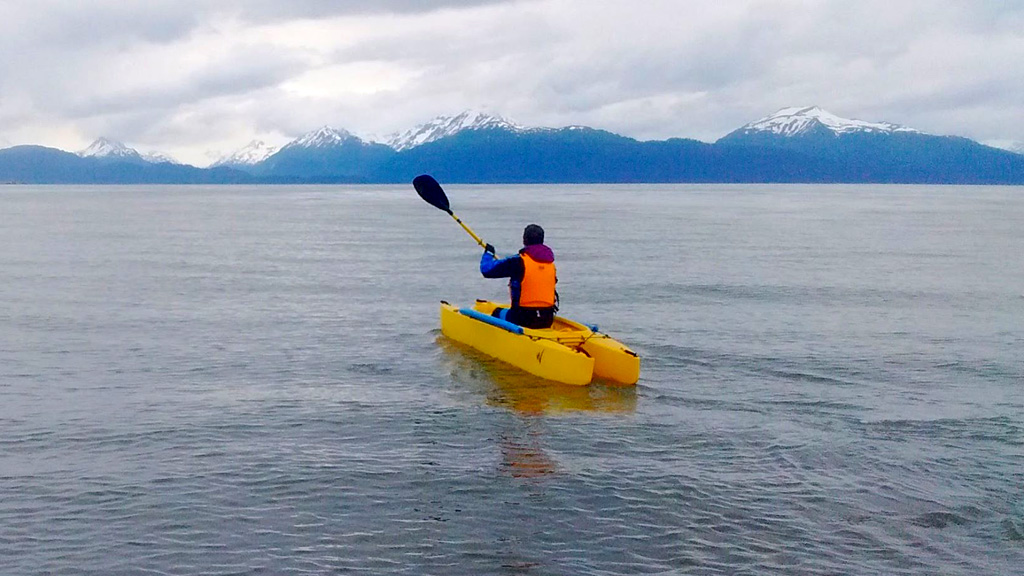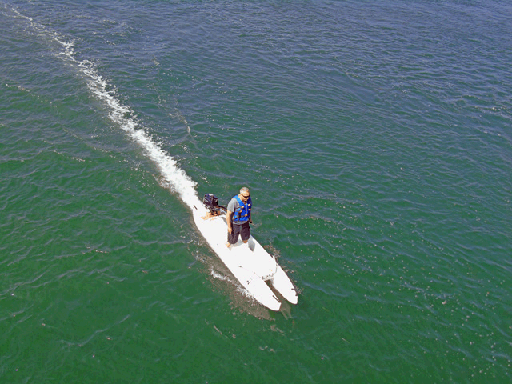Featured image: Pat Irwin, a kayaker with Multiple Sclerosis (MS) paddling his Wavewalk 500 in Alaska. The small W500 has been replaced by the bigger and much more stable W720 and S4.
If you looked at ads run by certain fishing kayak manufacturers, you might get the impression that typical kayak anglers are twenty-something athletes with six-pack abs and toilet-bowl white smiles, who can easily fish standing on the hyper-accessorized decks of their SOT kayaks, or pedal those things while operating a rudder in one hand and a fishing pole in the other…
But ads in glossy magazines and carefully crafted YouTube videos are not necessarily good sources of real-world information.
In reality, while some young people fish from kayaks, the typical kayak angler is middle aged or elderly, and often suffers from physical issues and sometimes even disabilities. The most common problems are excessive weight and height, which limit the angler’s ability to balance and operate their kayak. Equally common are back pain and sensitivity, which limit the angler’s ability to carry the kayak, paddle it, sit comfortably in it, and stay in it for the long periods of time normally required by fishing trips.
Our website features countless accounts and articles related to back pain, leg numbness and other common problems, as well as numerous accounts by clients who suffer from more severe physical impairments and disabilities.
This article will attempt to summarize what we know about the more severe conditions in relation to operating kayaks and fishing from them –
Consulting with your expert physician on these matters is highly recommended, of course. The fact a person suffers from a condition listed here does not automatically mean the W kayak is good for them. There may be cases that would prevent you from enjoying our W kayak, and even cases where using it might altogether be unrecommended to you, for various reasons. We welcome your questions even if you have a slight doubt. In some cases we could offer you to contact clients who suffer from a condition similar to yours, so you could ask them about their personal experience.
Fibromyalgia syndrome – a rheumatoid disorder characterized by chronic pain in the muscles and soft tissues surrounding joints, fatigue, and tenderness at specific sites in the body. This condition makes it practically impossible to sit in the L position, which all kayaks require, except the W kayak.
Multiple sclerosis (MS) – a chronic degenerative disease of the central nervous system interfering with the nerve pathways and causing mild to severe neural and muscular impairments, loss of coordination, and speech and visual disturbances. This severe condition often leads to balance problems as well, and therefore difficulties in operating kayaks and fishing from them. We have clients with MS who enjoy riding the saddle of their W kayak while they paddle it and fish from it, and they prefer to use outriggers, for extra safety.
Arthritis – inflammation of a joint or joints caused by gout, rheumatic fever, etc. and characterized by pain and stiffness of the affected parts. Numerous arthritic people enjoy paddling W kayaks and fish from them. The extra comfort and dryness offered by our kayak design make it easier for them in every way.
Sciatica – a painful condition in the region of the thighs and hips, usually caused by a herniated disk of the lumbar region of the spine (lower back). Many people who suffer from Sciatica paddle and motorize W kayaks for long hours. They enjoy the comfort of the W saddle, the ability to switch between multiple positions anytime they want, the ease of standing up anytime and for as long as they want, and the ability to stretch their back and limbs lying down on the saddle. Our fishing kayak has many fans among people who suffer from Sciatica.
Spinal fusion – a surgical procedure that corrects an unstable part of the spine by joining two or more vertebrae. Forget about traditional kayaking if you’ve had spinal fusion surgery, unless you have a W kayak. We have more than one client who use their W kayak for long touring and fishing expeditions, and praise the comfort it provides despite their extreme back sensitivity.
Herniated disk (a.k.a slipped disk) – abnormal, painful protrusion of a disk between spinal vertebrae which occurs most often in the lumbar region (lower back). No way for you to paddle a regular kayak if you suffer from this painful condition, but the W kayak may be a solution for you, judging by what people who suffer from this condition and enjoy using their W kayaks have to tell.
Knee replacement – a surgical procedure to replace the weight-bearing surfaces of the knee joint with metal and plastic components to relieve the pain and disability of osteoarthritis. People who suffer from serious knee problems find it hard to get into a sit-in kayak, as well as get out of it. Similarly, sit-on-top kayaks are not friendly either for such people, not just because of entry and exit issues, but also because of the need to sit in the infamous L position for a long time. In contrast, we have numerous clients with serious knee problems who praise their W kayaks as being the only ergonomic solution for them.
Hip replacement – a surgical procedure in which the hip joint is replaced by a prosthetic implant. This condition rules out spending time in the L kayaking position, for obvious reasons. The alternative can be to paddle or motorize a W kayak, as some people who have had their hip replaced indeed do.
Balance disorder – a disturbance that causes an individual to feel unsteady, as a result of a dysfunction of one or more of the body systems working together to provide balance: The eyes (visual system), ears (vestibular system), the body’s sense of where it is in space (proprioception), and the brain, which compiles this sensory information. Many people who want to spend time paddling and fishing although they suffer from various balance disorders, find the W kayak to provide an adequate solution. The enhanced physical stability of the W kayak design, combined with the ability the users are offered to balance the craft with their legs while riding a high saddle, make the W kayak the only serious solution for them.
Low back pain (lumbago) is a common musculoskeletal disorder affecting 80% of people at some point in their lives. Over 99% of low back pain instances stem from benign musculoskeletal problems, and are referred to as non-specific low back pain; this type may be due to muscle or soft tissues sprain or strain, particularly in instances where pain arose during physical loading of the back, with the pain lateral to the spine. It would surely not come as a surprise to the reader to learn that a large proportion of our clients came to love their W kayak thanks to the fact that it offers them a back pain free ride like no other kayak can.
Degenerative disc disease (DDD) – Degeneration of the intervertebral discs of the spine is a condition that can be painful and can greatly affect the quality of one’s life. While disc degeneration is a normal part of aging and for most people is not a problem, for certain individuals a degenerated disc can cause severe constant chronic pain. Even people who suffer from DDD can enjoy paddling a W kayak and fishing out of it, as our website’s customer reviews section can tell.
Do you have any questions for us?



